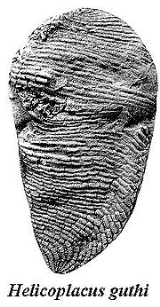
Helicoplacus
Encyclopedia
Helicoplacus is the earliest well-studied fossil
echinoderm. Fossil plates are known from several regions. Complete specimens were found in Lower Cambrian
strata
of the White Mountains of California
.
The animal was a cigar-shaped creature up to 7 centimetres (2.8 in) long that stood upright on one end. Unlike more typical echinoderms such as sea star
s, Helicoplacus does not have fivefold symmetry. Instead, there is a spiral food groove on the outside along which food was moved to a mouth that is thought to be located on the side. The respiratory system appears to be primitive. Although the animal does not look like a typical echinoderm, the plates are composed of the characteristic calcareous plates known as stereom
that are common to all echinoderms. The ambulacrum is similar to that of the Edrioasteroidea
; as a result, Helicoplacoidea may belong to Pelmatozoa
.
Other contemporaneous echinoderms are known to have existed from their dissociated plates, but other than a few possible edrioasteroids, Helicoplacus is the earliest echinoderm that is well enough preserved to analyze its characteristics. One much earlier form called Arkarua
has been hypothesized to be an ancestral echinoderm because of its fivefold symmetry. But Arkarua appears to lack both stereoms and a mouth.
Helicoplacoids seem to have existed for about 15 million years in the Lower Cambrian, around .
Helicoplacoids are thought to have been suspension feeders living at moderate depths in highly-oxygenated water with strong enough currents to ensure a steady food supply. They are typically found in greenish shale
s and are rarely found in shallow water sandstone
s and limestone
s.
Fossil
Fossils are the preserved remains or traces of animals , plants, and other organisms from the remote past...
echinoderm. Fossil plates are known from several regions. Complete specimens were found in Lower Cambrian
Cambrian
The Cambrian is the first geological period of the Paleozoic Era, lasting from Mya ; it is succeeded by the Ordovician. Its subdivisions, and indeed its base, are somewhat in flux. The period was established by Adam Sedgwick, who named it after Cambria, the Latin name for Wales, where Britain's...
strata
Stratum
In geology and related fields, a stratum is a layer of sedimentary rock or soil with internally consistent characteristics that distinguish it from other layers...
of the White Mountains of California
California
California is a state located on the West Coast of the United States. It is by far the most populous U.S. state, and the third-largest by land area...
.
The animal was a cigar-shaped creature up to 7 centimetres (2.8 in) long that stood upright on one end. Unlike more typical echinoderms such as sea star
Sea star
Starfish or sea stars are echinoderms belonging to the class Asteroidea. The names "starfish" and "sea star" essentially refer to members of the class Asteroidea...
s, Helicoplacus does not have fivefold symmetry. Instead, there is a spiral food groove on the outside along which food was moved to a mouth that is thought to be located on the side. The respiratory system appears to be primitive. Although the animal does not look like a typical echinoderm, the plates are composed of the characteristic calcareous plates known as stereom
Stereom
Stereom is a calcium carbonate material that makes up the internal skeletons found in sea urchins, and all other echinoderms, both living and fossilized forms. It is a sponge-like porous structure which, in a sea urchin may be 50% by volume living cells, and the rest being a matrix of calcite...
that are common to all echinoderms. The ambulacrum is similar to that of the Edrioasteroidea
Edrioasteroidea
The Edrioasteroids are an extinct class of echinoderm that lived from the Ediacaran to the Permian periods of geologic time, about...
; as a result, Helicoplacoidea may belong to Pelmatozoa
Pelmatozoa
Pelmatozoa is a clade of Phylum Echinodermata. It includes stalked and sedentary echinoderms.The main class of Pelmatozoa is Crinoidea which includes sea lily and feather star....
.
Other contemporaneous echinoderms are known to have existed from their dissociated plates, but other than a few possible edrioasteroids, Helicoplacus is the earliest echinoderm that is well enough preserved to analyze its characteristics. One much earlier form called Arkarua
Arkarua
Arkarua is a small, Precambrian disk-like fossil with a raised center, a number of radial ridges on the rim, and a five-pointed central depression marked with radial lines of 5 small dots from the middle of the disk center...
has been hypothesized to be an ancestral echinoderm because of its fivefold symmetry. But Arkarua appears to lack both stereoms and a mouth.
Helicoplacoids seem to have existed for about 15 million years in the Lower Cambrian, around .
Helicoplacoids are thought to have been suspension feeders living at moderate depths in highly-oxygenated water with strong enough currents to ensure a steady food supply. They are typically found in greenish shale
Shale
Shale is a fine-grained, clastic sedimentary rock composed of mud that is a mix of flakes of clay minerals and tiny fragments of other minerals, especially quartz and calcite. The ratio of clay to other minerals is variable. Shale is characterized by breaks along thin laminae or parallel layering...
s and are rarely found in shallow water sandstone
Sandstone
Sandstone is a sedimentary rock composed mainly of sand-sized minerals or rock grains.Most sandstone is composed of quartz and/or feldspar because these are the most common minerals in the Earth's crust. Like sand, sandstone may be any colour, but the most common colours are tan, brown, yellow,...
s and limestone
Limestone
Limestone is a sedimentary rock composed largely of the minerals calcite and aragonite, which are different crystal forms of calcium carbonate . Many limestones are composed from skeletal fragments of marine organisms such as coral or foraminifera....
s.
External links
- Pictures of 'Helicoplacus' can be found at http://www.usna.edu/Users/oceano/pguth/website/pl00001.htm

